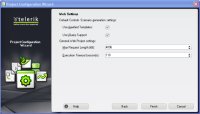Getting Started with Telerik RadControls ASP.NET AJAX
Here at Visual Studio Magazine, we hadn't reviewed a component suite for a long time, so we decided it was about time to look at this important area of the Visual Studio toolspace. In our May issue,
we published a review of a new suite from
Telerik, in part because Telerik's suites have earned top billing in our Reader's Choice awards on a number of occasions. The company also recently released new versions of all of its control suites.
Telerik makes several component suites, but we looked at Telerik's RadControls for ASP.NET AJAX because, well, AJAX is cool and the announcements from the Microsoft MIX10 conference this spring focused interest in this area.
Reviewing a component suite also gives me an excuse to look at the "suite side" of the Visual Studio toolspace. After all, when reviewing a controls suite, you have to wonder "Why bother?" Don't they all work? Aren't they all so huge that "they all have everything"?
If that's the case (that, from far enough away, all the suites look alike), then the only basis for making a decision is price: get the cheapest. You could tweak that, of course, by looking at upgrade costs, support, etc. -- but that's just really looking at the "Total Cost of Ownership." It's still a price thing. To try and understand that better, spoke to Stephen Forte, chief strategy officer at Telerik. You can see what he had to say about the suite market and what it takes to compete in the market here and here.
From a reviewer's point of view, you have to wonder how many people are going to buy a suite based on a review? You wonder if most people made their decision long ago and have numerous applications built around that suite. They're not going to switch to another suite and they're only going to upgrade within the suite they already own. Granted, each year there has to be some developers who are buying their "first suite," but is the market actually growing? I've got an interview coming up with Mark Driver, vice president of Research at the Gartner Group, where he provides his take on component suites market. Look for that later this week.
Installing Telerik's RadControls for ASP.NET AJAX
By now you may have already read the print version of my review of Telerik RadControls for ASP.NET AJAX. Here on my ToolTracker blog, however, you can get an in-depth look not just at the products I review, but in the way I go about reviewing them. You can check out my series of in-depth looks at Nevron's Diagram for .NET for another example of what I'm up to here.
So let's dive into Telerik's RadControls for ASP.NET AJAX. As usual, I sent an e-mail off to Telerik asking if they wanted to provide me with a copy of their product for testing. With very few exceptions, I prefer to review the "real" bits that a developer would work with, rather than a trial version. Many, many years ago, when reviewing a product, I hit a limitation of the trial version and wrote it up as a limitation of the real product -- very embarrassing.
While I was waiting for a response, I downloaded the trial version of the Telerik controls figuring that I'd later get a license from the company to "turn on" the full version. The download went quickly as did the install. During the installation, you can choose to have both .NET 2.0 and .NET 3.5 assemblies installed (I took just the 3.5 assemblies).
Once the product was installed, I started Visual Studio and found I had a new menu choice: Telerik. With just one of Telerik's suites installed you get sort of an odd menu: one entry that's got a submenu with a single entry in it ("Create New Telerik Project"). Selecting it opens the standard New Project dialog but with a new project type selected: Telerik. I selected "RadControls Web Site" (my other choice was "RadControls Web Application"). This starts a wizard that gave me an opportunity to select some additional options, including whether I would add Telerik's servers to my list of CDN servers and enabling jQuery support (Figure 1).

[Click on image for larger view.] |
| Figure 1.When you create a project from your new Telerik menu, you have the option to set some additional project settings that control how your Telerik controls will behave. |
About at this point, Telerik got back to me with the URL where I could download the official version of the suite and told me that I'd need to replace the trial version with it -- no license key is required with the "real" version. Telerik has, essentially, done away with license/activation keys on the philosophy that it just makes controls harder to install and manage. The trial version bits and the full version bits are identical (so I'm told) except for a message that pops up occasionally when using the trial version.
Telerik also pointed me to a page on handling upgrades which I found a little intimidating. The major issue is swapping out the Telerik DLLs in any existing Web site to replace them with the new versions (and to reconcile any changing functionality). I'm thinking that, when upgrading the controls, it might be simpler to keep the old version on any existing projects that use them and use the new versions only on new projects. This process also suggests that, if you're trying out the controls, you should use a "throw away" project.
Worth mention: I'm testing in Visual Studio 2008 and .NET 3.5. I mention that because (a) I'm currently trying out Visual Studio 2010 and may get confused; (b) Telerik advertises the controls as being ready for Visual Studio 2010, so it's not unreasonable to expect that I might be using 2010.
I'll offer insight on the upgrade process tomorrow.
Posted by Peter Vogel on 05/25/2010